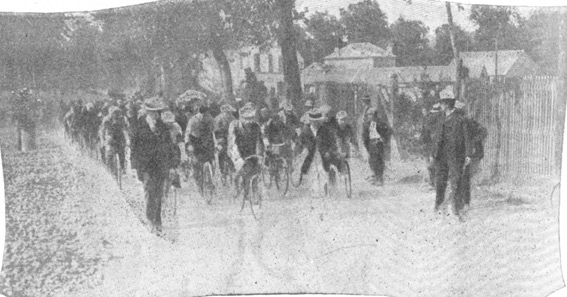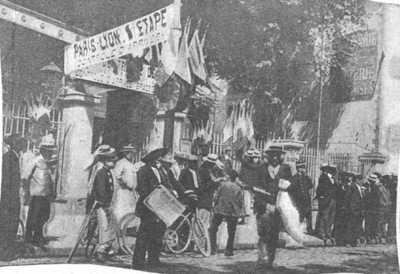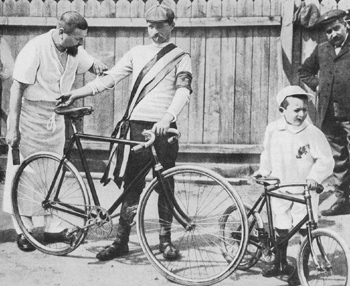30 Jul 2013
27 Jul 2013
Guidelines for Cyclists by Delhi Traffic Police
In order to be safe while cycling on roads of Delhi, keep the following tips in mind.Before you go out on the road with your bicycle, ensure that:a. You should wear:
b. Follow these rules:
Source: http://www.delhitrafficpolice.nic.in/guidelines-for-cyclists.htm
|
26 Jul 2013
Why Not? Around the world on the saddle!
Alastair Humphreys at TEDxHull
Alastair Humphreys has spent over four years cycling round the world, a journey of 46,000 miles through 60 countries and five continents. He's walked across Southern India following the Kaveri river, rowed the Atlantic Ocean, ran the Marathon des Sables, completed a crossing of Iceland by foot and packraft and participated in an expedition in the Arctic, close to the magnetic North Pole. Alastair has also recently returned from walking across the Empty Quarter retracing the route of one of his heroes, Wilfred Thesiger, walking 1000 miles in 45 days through the desert in Oman.
23 Jul 2013
Mother of all Bike PJs : )

Q: What is a ghost-proof bicycle?
A: One with no spooks in it.
Q: Which is the cheapest bicycle you can buy?
A: Penny-farthing.
Q: What's the hardest thing about learning to ride a bicycle?
A: The road.
Q: When is a bicycle not a bicycle?
A: When it turns into a driveway.
Q: What did the bicycle call its dad?
A: Pop-cycle
Q: How many bikers does it take to change a light bulb?
A: It takes two. One to change the bulb, and the other to kick the switch.
O: What do you get if you cross a chemical and a bicycle ?
A: Bike carbonate of soda !
Q: Why can't a bicycle stand up by itself?
A: Because it is two-tired (too tired).
Q: Why can't an elephant ride a bicycle?
A: Because he doesn't have a thumb to ring the bell.
Q: Which Elizabethan sailor could stop bikes ?
A: Sir Francis Brake !
Q: What do you get if you cross a bike and a rose ?
A: Bicycle petals !
Q: Why couldn't Cinderella win the bicycle race?
A: She has a pumpkin for a coach!
Q: Why are bank tellers not allowed to ride bicycles?
A: They tend to lose their balance.
Q. Did you hear about the vampire bicycle that went round biting people's arms off?
A. It was a vicious cycle.
18 Jul 2013
11 Jul 2013
Bike Dates: TOT
 |
|
|
Category: Endurance Cycling
Date: 5th - 12th Oct
Location: Terai
Details: 8 day Tour with competitive time trial sections.
Route: Starts from Tiger country Jim Corbett National Park and climbs into the Shivalik Range of Himalayas.
In conversation with the Tour Organizers - FAQs
1. What kind of training should be done to prepare for the Tour?
Ans: The rider need to focus on doing hill repeats. If the same is not available, do at least one 80-100 km ride every week to build endurance, besides riding 25-30 km on other days. If rider is on the heavier side, losing weight would help. Off the bike - squats and lunges are a good exercises to do. Building core and muscles will surely help by giving more power and less pain. Three months is a good time to start from scratch and be able to finish the tour like a tiger.
2. What is the terrain going to be like?
Ans: Tour of Tigers is entirely based on Hilly terrain with good roads through and through, leaving some average tarmac patches. This makes it friendly for all Road bikes, Hybrids and MTBs.
3. Are any specific accessories needed for the bike?
Ans: While no special accessories are needed, one must carry spare brake shoes, tubes and if possible tyres. The bike must have a front light and a tail light.
4, Who all are eligible to ride?
Ans: While all individuals who are 18 years and above are eligible to ride, given the riding challenge, it is strongly recommended that one comes with ample preparation and/or experience.
5. What are the weather conditions expected?
Ans: October is a pleasant 20 degrees in the day time and around 10-15 degrees in the evening.
6. Is there any time limit involved to finish?
Ans: The daily ride would start between 7- 8 AM till Sunset, with around 10-11 hrs to finish the day's ride. The ones who are unable to finish, will be picked up by the support team.
7. How are the roads of the Tour?
Ans: 95% are good tour roads, including new and old Tarmac. The region of the Tour has stayed unaffected with the recent flood in Garhwal Hills. There are a few places where the Tarmac is old or the road has patches and potholes but all of these sections too are doable on a Road bike. Do note that part of the Tour is on the Hilly National highway with wide roads and moderate/thin traffic, and part of the tour is on State/District roads with narrow width and thin/surprising traffic.
8. What kind of food and accommodation will be provided during the Tour?
Ans: Tour of Tigers is an event for and by cyclists. The team understands the importance of proper nutrition and rest needed during such multi-day events. There will be time bound Buffet Breakfast and Dinner and packed lunch during the ride, besides ride time nutrition and beverages. Accommodation will be shared and will be in good properties/resorts. Wherever possible, option of upgrading to single will be made available. This option can be selected during the registration.
9. What kind of support can one have during the ride?
Ans.Tour of Tigers is an organiser supported event. This means that riders will have limited access to organising vehicles to keep/retrieve their stuff. Besides this, the riders are allowed to have a personal support vehicle, which can meet the rider as needed, but will never be allowed to trail or lead the rider. Towards the end of the day, a sweep vehicle will pick the riders who are falling behind the time controls. No exception will be made for any rider in this case. The tour orgnisers will take care of luggage movement and room allocation during the tour, unless its managed by the rider's support team.
10. Will there be any prizes given?
Ans: Yes. There will be prizes for the Time Trials and over all finish sections.
https://www.facebook.com/Touroftigers
Ans: The rider need to focus on doing hill repeats. If the same is not available, do at least one 80-100 km ride every week to build endurance, besides riding 25-30 km on other days. If rider is on the heavier side, losing weight would help. Off the bike - squats and lunges are a good exercises to do. Building core and muscles will surely help by giving more power and less pain. Three months is a good time to start from scratch and be able to finish the tour like a tiger.
2. What is the terrain going to be like?
Ans: Tour of Tigers is entirely based on Hilly terrain with good roads through and through, leaving some average tarmac patches. This makes it friendly for all Road bikes, Hybrids and MTBs.
3. Are any specific accessories needed for the bike?
Ans: While no special accessories are needed, one must carry spare brake shoes, tubes and if possible tyres. The bike must have a front light and a tail light.
4, Who all are eligible to ride?
Ans: While all individuals who are 18 years and above are eligible to ride, given the riding challenge, it is strongly recommended that one comes with ample preparation and/or experience.
5. What are the weather conditions expected?
Ans: October is a pleasant 20 degrees in the day time and around 10-15 degrees in the evening.
6. Is there any time limit involved to finish?
Ans: The daily ride would start between 7- 8 AM till Sunset, with around 10-11 hrs to finish the day's ride. The ones who are unable to finish, will be picked up by the support team.
7. How are the roads of the Tour?
Ans: 95% are good tour roads, including new and old Tarmac. The region of the Tour has stayed unaffected with the recent flood in Garhwal Hills. There are a few places where the Tarmac is old or the road has patches and potholes but all of these sections too are doable on a Road bike. Do note that part of the Tour is on the Hilly National highway with wide roads and moderate/thin traffic, and part of the tour is on State/District roads with narrow width and thin/surprising traffic.
8. What kind of food and accommodation will be provided during the Tour?
Ans: Tour of Tigers is an event for and by cyclists. The team understands the importance of proper nutrition and rest needed during such multi-day events. There will be time bound Buffet Breakfast and Dinner and packed lunch during the ride, besides ride time nutrition and beverages. Accommodation will be shared and will be in good properties/resorts. Wherever possible, option of upgrading to single will be made available. This option can be selected during the registration.
9. What kind of support can one have during the ride?
Ans.Tour of Tigers is an organiser supported event. This means that riders will have limited access to organising vehicles to keep/retrieve their stuff. Besides this, the riders are allowed to have a personal support vehicle, which can meet the rider as needed, but will never be allowed to trail or lead the rider. Towards the end of the day, a sweep vehicle will pick the riders who are falling behind the time controls. No exception will be made for any rider in this case. The tour orgnisers will take care of luggage movement and room allocation during the tour, unless its managed by the rider's support team.
10. Will there be any prizes given?
Ans: Yes. There will be prizes for the Time Trials and over all finish sections.
8 Jul 2013
The Patron Saints Of Cyclists
Italy: Madonna del Ghisallo
Madonna del Ghisallo is the patroness of cyclists', as proclaimed by Pope Pius XII during the 1949 Giro d'Italia. The greatest riders in the world like Coppi and Bartali have given their bicycles and jerseys to the church by way of thanks for winning races. Giro di Lombardia (Lombardia 's Tour) is the last race of World Cup and even if they change the route, it always includes Ghisallo.
 |
| France: Notre Dame des Cyclistes |
An 11th-century chapel has been dedicated to the heroes of the Tour de France since 1959. Father Massie had a self-confessed passion for the Tour de France and followed the example of the Italians with La Madonna del Ghisallo. He went to the Vatican to receive the authorisation from Pope Pius XII in person and the official inauguration of the chapel took place on Whit Monday 1959.
5 Jul 2013
4 Jul 2013
2 Jul 2013
The First Tour De France

Distance: 2,428 km
Average speed: 25.68 km/hr
60 Riders
21 classified finishers
The Tour de France was suggested to Henri Desgrange, editor of L'Auto (ancestor to today's l'Equipe), as a sales promotion to win a circulation war with competing sports newspaper Le Vélo. It was to be a Six-Day race, only on the road, which would have to start in the dark and could take over 17 hours to complete. The race proved to be an instant hit, L'Auto's circulation soared and Desgrange went down in history as the father of the greatest sporting event in the world.
On Jan 19, 1903, L'Autoannounced the first Tour de France, "the greatest cycling trial in the entire world". The first schedule was for a 5-week race with the winner as the racer with the lowest elapsed time racing after all the stages. This total time is still called the "General Classification". A week before the start only 15 riders had signed up, so Desgrange shortened and re-scheduled the race, promised expense money of 5 francs a day to the first 50 racers who signed up and dangled a 20,000 franc purse of prize money.
At 3:16 PM, July 1, 1903, the first peloton of 60 riders departed from the now famous Cafe au Réveil-Matin in Montgeron on the southern outskirts of Paris, of these 21 were sponsored or professional racers. They were to ride 6 stages totaling a staggering 2,428 kilometers. Desgrange wanted his race to be a superhuman test of an individual's endurance and strength, so pacers were banned except for the final stage.
 | |||
The riders get ready to start.
| |||
 | |||
Desgrange's 60-man peloton riding together
| |||
Maurice Garin, nicknamed "the Chimney-Sweep", in the red, white and blue tricolor bike of his sponsor, La Française, won the first stage of the first Tour, beating Émile Pagie by 55 seconds and held the lead throughout the Tour. Only 37 riders were able to complete the day's racing. The last rider took more than 20 hours longer than Garin to get to Lyon.
 | |||
The first stage finish line in Lyon
| |||
 | |||
Leon Georget finishes third in the first stage, 34 min, 59 sec behind stage winner Garin. Georget would drop out of the Tour in stage 5.
| |||
 |  | |||||
Maurice Garin, in his trademark white coat and flat cap racing in the '03 Tour
| ||||||
Best action photo ever seen of Garin
| ||||||
On July 19, only 21 riders of the 60 finished the TDF. The 20,000 spectators at Paris' Parc de Princesvelodrome saw Maurice Garin win the final stage and win the Tour. The final finisher came in over two days later. While the famed "Yellow Jersey" worn by the man leading the Tour would not be adopted until 1919, Garin was given a green armband to signify his lead during the 1903 Tour, and the Lanterne Rouge or Red Lantern was used to designate the rider in last place. Arsène Millocheau has the dubious fame of being the first Lanterne Rouge by coming in at 64 hours, 57 minutes, 8 seconds behind Garin in total time.
 | |||||
Garin is greeted by enthusiastic fans.
| |||||
 | |||||
1903 Tour winner Maurice Garin having a smoke. Pictured with him are his son (on right with little bike) and his masseur.
| |||||
Garin pocketed 6,125 francs for his exploit, about $40,000 in U.S. dollars today. His winning margin of 2 hours and 49 minutes remains the largest in Tour history. The first Tour at 2,428 km remains the second shortest ever. The average speed for the first Tour was 25.679 km per hour. The 50th Anniversary Tour in 1953 averaged 34.593 km per hour and the speed of the Centennial 2003 Tour was 40.94 km per hour.
 | ||
Racers at the feed zone, 1903.
| ||
The Tour was a fantastic success. Circulation of L'Auto boomed. 130,000 copies were printed for the final stage (an increase of 100,000). Le Vélo went out of business and the Tour de France was born.
Final 1903 Tour de France General Classification:
- 1. Maurice Garin: 94 hours 33 minutes 14 seconds
- 2. Lucien Pothier @ 2 hours 59 minutes 2 seconds
- 3. Fernand Augereau @ 4 hours 29 minutes 24 seconds
- 4. Rodolphe Muller @ 4 hours 39 minutes 30 seconds
- 5. Jean Fischer @ 4 hours 58 minutes 44 seconds
 | ||
Leon Georget signs in under the watchful eye of an official. To minimize cheating riders signed in a stops along each stage.
(Excerpt is from "The Story of the Tour de France", Volume 1) |
Subscribe to:
Posts (Atom)









